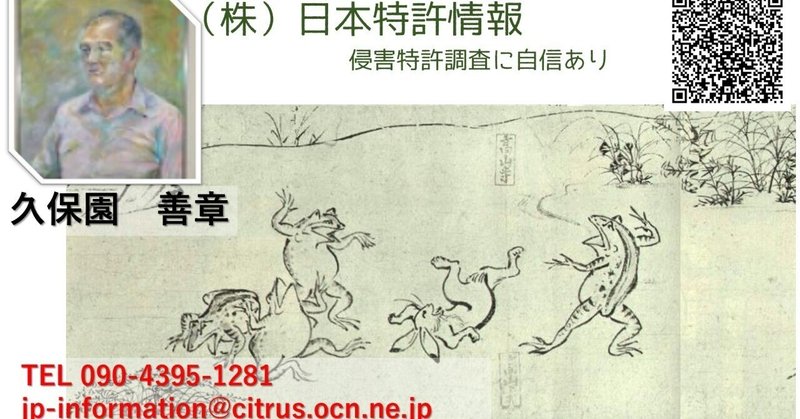
(裁判-1)裁判所の判決文で、東京地方裁判所で下された判例です。
https://drive.google.com/file/d/1t7pwZ92FHcpUmOJIvVxAkNl_18ygc2RT/view?usp=sharing
https://drive.google.com/file/d/109N_RvPwM5EzgKUwGTJrqZmxW14Tv0P8/view?usp=sharing
https://drive.google.com/file/d/15Am-y-9101MY8TZijp4jdSrQOTevTJrO/view?usp=sharing
令和元年(ワ)第25121号(令和3年12月9日判決言渡)で、特許6538097を「権利無効」としたものです。
判決文の総ページ数は69枚とさほど多くはありませんが、各ページの下段に「ページ数」が付されていません。
裁判所の判決文は、所謂「紐無し褌文(ひも無しふんどし文)」(段落なしの文章)で、プレーヤーが原告、被告および裁判所の3名、そして「特許明細書」や「審決」など、更には「別紙」などのファクトがあります。
本件は、原告、被告の代理人数が少なく、フロントページに「主文」が書かれているケースです。
(本来ならば、代理人は原告・被告とも1名の記載だけで十分と思われます)。
判決文を読んで、理解するには、先ずは「段落の無い文章」の慣れることです。
先ずは、「PDF」と「テキスト」文章を入手し、これに「ハイライト記号」(多色)を付して、文章を解剖する必要があります。
そして、ファクトの部分を飛ばして、「原告の主張」、「被告の主張」、そして肝心な「当裁判所の判断」のところを色分けして、読み込みます。
何はともあれ、裁判所の判断の後段の「結論」のところの要部を切り取ります。
なお、本件における東京地方裁判所の判断においては、当事者の争点が11件あるにもかかわらず、この内5件しか判断をしていません。
そして、東京地方裁判所は、「以上によれば、原告らの主張はいずれも採用することができない。」として、原告が有する特許を「権利無効」としました。
ところで、知財部門に配属されている技術系の担当者は、常日頃からこの「ふんどし文」である裁判記録に慣れるようにすべきです。(慣れてしまえば、こっちのものです)。
なおここで、「裁判文章の標準的な書式、標記法」を添付します。
https://drive.google.com/file/d/1drJUcrWJKef1ureMAiik8fLyLDFtYybP/view?usp=sharing
(Google Translation)
(Court-1) This is a court judgment, a precedent handed down by the Tokyo District Court.
No. 25121 of 2019 (Wa) (judgment handed down on December 9, 2021), patent 6538097 was declared invalid.
The total number of pages in the judgment is 69, which is not that many, but the ``page number'' is not marked at the bottom of each page.
The court's judgment is a so-called ``stringless loincloth sentence'' (a sentence without paragraphs), and the players are the plaintiff, the defendant, and the court, and there are documents such as ``patent specifications'' and ``trial decisions,'' etc.
Furthermore, there are facts such as "attached sheets".
This case is a case in which the plaintiff and defendant have only a small number of representatives, and the "main text" is written on the front page. (Originally, it would be sufficient to list only one agent for both the plaintiff and the defendant.)
In order to read and understand judgments, you must first become familiar with ``sentences without paragraphs.''
First, you need to obtain the "PDF" and "text" sentences, add "highlight marks" (multicolor) to them, and dissect the sentences.
Then, you can skip the fact section and read the "plaintiff's claim," "defendant's claim," and the important "judgment of this court" in different colors.
In any case, I will cut out the main part of the ``conclusion'' section at the end of the court's judgment.
Furthermore, in the Tokyo District Court's decision in this case, although there were 11 issues at issue for the parties, it only decided on 5 of them.
The Tokyo District Court ruled that the plaintiff's patent was invalid, stating, ``Based on the above, none of the plaintiffs' claims can be accepted.''
By the way, technical personnel assigned to the intellectual property department should regularly become familiar with court records, which are "loincloth documents."
(Once you get used to it, it's here).
At this point, we have attached the "Standard Format and Notation for Judgment Texts."
(Google 翻译)
(Court-1)这是法院的判决,是东京地方法院的判例。
2019(佤)第25121号专利(2021年12月9日下达判决),宣告第6538097号专利无效。
判决书总页数为69页,不算多,但每页底部都没有标注“页码”。
法院的判决是所谓的“无绳腰布刑”(没有段落的句子),扮演者是原告、被告和法院,并且有“专利说明书”和“专利说明书”等文件。
“审判决定”等。
此外,还有“附页”等事实。
本案是原告和被告代表人数较少,且“正文”写在首页的案件。
(原本,原告和被告只列出一名代理人就足够了。)
为了阅读和理解判断,你必须首先熟悉“没有段落的句子”。
首先,您需要获取“PDF”和“文本”句子,为其添加“突出显示标记”(多色),并对句子进行剖析。
然后,你可以跳过事实部分,阅读不同颜色的“原告主张”、“被告主张”以及重要的“本院判决”。
无论如何,我会把法庭判决书最后“结论”部分的主要部分删掉。
此外,东京地方法院在本案的判决中,虽然当事人的争议点有11个,但仅对其中的5个做出了判决。
东京地方法院裁定原告的专利无效,并表示 “基于上述情况,原告的任何主张均不可接受。”
顺便说一句,分配到知识产权部门的技术人员应该定期熟悉法庭记录,这些记录是“腰布文件”。
(一旦你习惯了,它就在这里)。
至此,我们附上了《判决书的标准格式及表示法》。
(ハッシュタグ)
#INPIT #JPlatPat #仕事について話そう #note #note毎日更新 #note毎日投稿 #note連続更新 #note連続投稿 #noteクリエイター #note応援部 #note毎日 #note海外組 #noteメンバーシップ #note日記 #note更新 #noteサークル #仕事 #仕事のコツ #仕事のポリシー #仕事論 #仕事効率化 #仕事観 #仕事ができる人 #仕事の話 #仕事内容 #仕事の仕方 #仕事の進め方 #仕事を楽しむ #仕事とは #仕事力 #ビジネス #ビジネススキル #ビジネスモデル #ビジネスチャンス #知財 #知財戦略 #知財塾 #知的財産 #知的財産権 #知的財産高等裁判所 #特許 #特許調査 #特許法 #特許庁 #特許事務所 #特許分類 #特許検索 #特許分析 #特許情報 #特許権者 #特許無効審判 #専利 #分類付与 #先行技術調査 #無効資料調査 #侵害調査 #侵害予防調査 #パテント #発明 #発明塾 #どうする特許庁 #検索論理式 #審査官 #審判官 #AI #AIの活かし方 #AI画像生成 #IT #ITエンジニア #IT業界 #IT企業 #ITベンチャー #IT化 #IT系 #ITリテラシー #ITツール #DX #DX化 #DX推進 #DX人材 #DX事例 #DXリテラシー #Patent #ChatGPT #ChatGPTの使い方 #ChatGPTが凄い #ChatGPTに聞いてみた #Chatgpt4 #Gemini #Threads #bing #bingAI #bingX #金子吉友 #一月万冊 #裁判所 #出願情報 #東京地方裁判所
この記事が気に入ったらサポートをしてみませんか?
